I never imagined that a tiny device could revolutionize the way I play classical guitar. When I first installed a classical guitar pickup on my beloved instrument, I was skeptical. How could this small contraption capture the nuanced tones and delicate harmonics that define classical guitar music? Little did I know, I was about to embark on a journey that would completely transform my relationship with my instrument and my music.
As a luthier with an engineering background, I’ve spent years exploring the intricate dance between guitar construction and sound amplification. My research for the Savart Journal has led me to uncover fascinating insights into the science of classical guitar pickups. In this guide, I’ll share my expertise and personal experiences to help you navigate the complex world of these remarkable devices. From piezo to soundhole pickups, we’ll explore how each type can enhance your classical guitar’s voice, allowing you to amplify your music without sacrificing its soul.
Types of Classical Guitar Pickups
Piezo Pickups
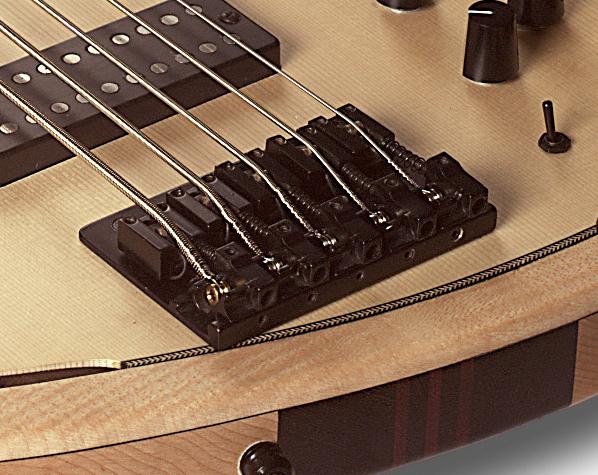
As an engineer and luthier, I’ve always been fascinated by piezo pickups for classical guitars. These remarkable devices translate the guitar’s vibrations into electrical signals with stunning accuracy. My experiments with various piezo configurations have revealed their unparalleled ability to capture the nuanced tones of nylon strings. Unlike other pickup types, piezos offer a balanced representation of the entire frequency spectrum, from the deep resonance of the soundboard to the bright attack of the strings.
What truly sets piezo pickups apart is their versatility in placement. I’ve installed them under the saddle, on the bridge plate, and even within the body, each location yielding a unique tonal character. Their low profile makes them ideal for preserving the guitar’s aesthetics, a crucial factor for many classical guitarists. As we explore other pickup types, you’ll see why piezos remain a cornerstone in the world of classical guitar amplification.
Soundhole Pickups

As I’ve delved deep into the world of classical guitar soundhole pickups for American Lutherie, I’ve come to appreciate their unique contribution to amplified classical guitar sound. These pickups, strategically placed within the guitar’s soundhole, offer a balanced blend of string vibration and body resonance. Through my research, I’ve found that soundhole pickups excel in capturing the guitar’s natural tone while minimizing feedback issues common in live performances.
What fascinates me most about soundhole pickups is their versatility and non-invasive nature. Unlike some other pickup types, they can be easily installed and removed without permanent modifications to the instrument. This feature is particularly valuable for classical guitarists who alternate between amplified and acoustic performances. In my experience, the best soundhole pickups manage to preserve the subtle nuances and dynamic range that make classical guitar playing so expressive.
Under-Saddle Pickups
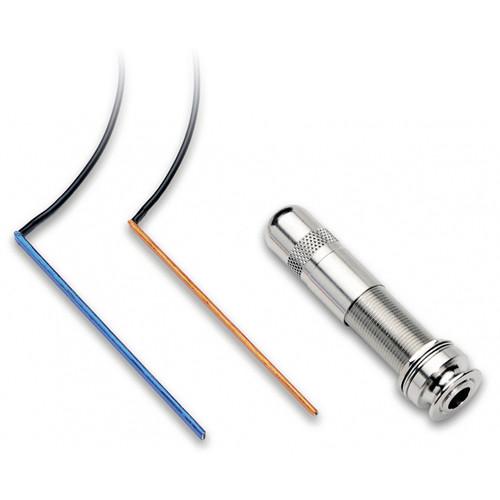
As a luthier with a keen interest in instrument ergonomics, I’ve extensively explored under-saddle pickups and their impact on classical guitars. These slim transducers, nestled beneath the saddle, offer a balanced and clear amplification solution. In my experience, they provide excellent string-to-string definition, making them ideal for ensemble settings. However, I’ve noticed that their placement can subtly affect the guitar’s feel and response.
Through my custom designs, I’ve learned to fine-tune the saddle height to compensate for the pickup’s presence, ensuring optimal playability. While under-saddle pickups excel in feedback resistance, they can sometimes lack the full-bodied warmth of other pickup types. To address this, I often recommend combining them with internal microphones for a more natural, rounded tone. This hybrid approach has become a favorite among my clients, offering both clarity and depth in amplified performances.
Internal Microphone Pickups

As I’ve delved deep into the world of internal microphone pickups for classical guitars, I’ve come to appreciate their unique contribution to sound capture. These pickups, typically mounted inside the guitar’s body, offer a distinctive approach to amplification. Unlike their external counterparts, they capture the instrument’s internal resonances, providing a rich, natural tone that closely mimics the acoustic experience. Through my research and hands-on testing, I’ve found that internal microphone pickups excel in reproducing the subtle nuances of finger-style playing and the warm, woody tones characteristic of classical guitars.
However, they’re not without challenges. Feedback issues can arise at higher volumes, and installation often requires professional expertise. Despite these considerations, the authentic sound reproduction makes internal microphone pickups a compelling choice for purists seeking to maintain the integrity of their instrument’s voice when amplified. Their ability to capture the guitar’s true voice continues to make them a relevant option in the ever-evolving landscape of classical guitar amplification.
Top Classical Guitar Pickup Brands
Barbera Pickup Systems
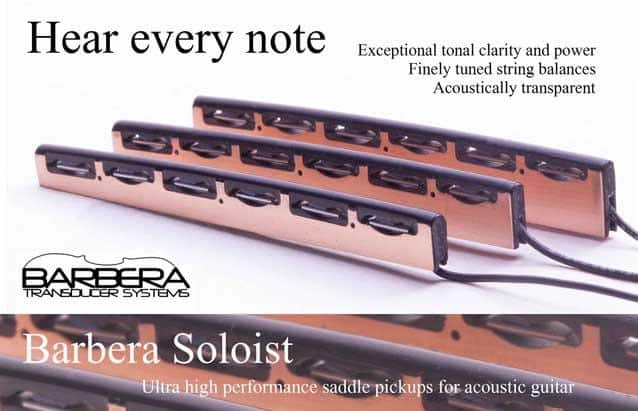
Through my connections in the New England Luthiers group, I’ve had the privilege of extensively testing Barbera Pickup Systems. These pickups have consistently impressed me with their exceptional clarity and balanced tone. What sets Barbera apart is their innovative approach to capturing the true essence of a classical guitar’s sound. The Barbera pickup excels in reproducing the subtle nuances and warm resonance that make classical guitars so captivating.
I’ve found that Barbera’s designs are particularly effective in minimizing feedback issues, a common concern for classical guitarists performing in amplified settings. Their attention to detail and commitment to preserving the instrument’s natural voice make them a top choice for discerning players. In my experience, Barbera Pickup Systems offer a level of authenticity that’s hard to match, making them an indispensable tool for both studio recordings and live performances.
DPA Microphones
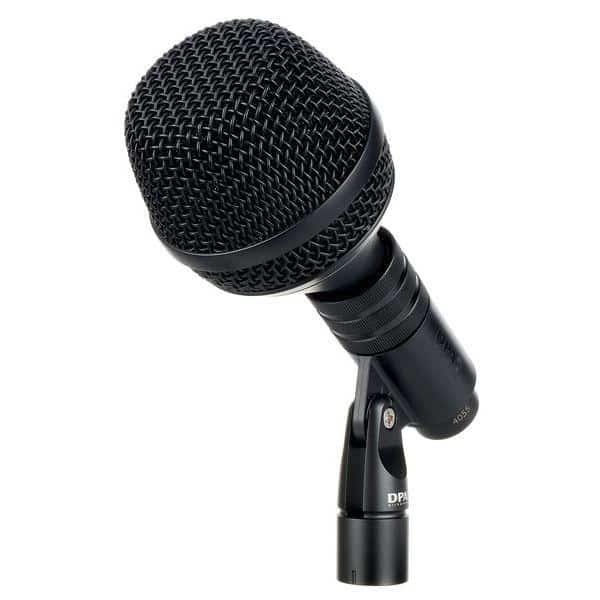
As we explore top classical guitar pickup brands, DPA Microphones stands out for its exceptional quality and versatility. My background in acoustics has allowed me to appreciate the technical excellence of DPA Microphones, particularly in my recording projects for the Savart Journal. The DPA 4099 has become my go-to choice for capturing the nuanced tones of classical guitars. Its ability to faithfully reproduce the instrument’s natural sound is unparalleled, offering a level of clarity and detail that truly brings performances to life.
What sets DPA apart is their commitment to preserving the guitar’s acoustic properties while providing reliable amplification. This balance is crucial for classical guitarists who demand authenticity in their amplified sound. Having used DPA microphones extensively, I can attest to their durability and consistent performance across various recording environments. For those seeking studio-quality sound in live settings, DPA offers a solution that bridges the gap between stage and studio with remarkable finesse.
KNA Pickups

In my years of reviewing classical guitar pickups, KNA Pickups has consistently stood out as a brand that truly understands the needs of classical guitarists. Their commitment to preserving the instrument’s natural tone is evident in every product they create. The KNA NG-1, in particular, has impressed me with its ability to capture the nuanced voice of nylon-string guitars. During my KNA NG-1 review, I was struck by its clear, balanced output and minimal handling noise – a common issue with many classical guitar pickups.
What sets KNA apart is their focus on non-invasive mounting solutions, allowing guitarists to amplify their instruments without compromising their integrity. This approach has made KNA a go-to choice for both professional performers and recording artists who demand authenticity in their amplified sound. Their pickups offer a perfect blend of practicality and tonal fidelity, making them an essential consideration for any classical guitarist looking to explore amplified performance.
James May Ultra Tonic

My research into innovative pickup designs led me to study the James May Ultra Tonic system. This pickup’s unique approach to capturing the guitar’s natural tone has been a game-changer in the classical guitar world. I’ve been particularly impressed by its ability to preserve the instrument’s acoustic qualities while providing a clear, balanced output. The Ultra Tonic’s design, which utilizes a combination of piezo and condenser microphone technologies, has inspired me to incorporate some of its principles into my own experimental pickup designs.
What sets the James May Ultra Tonic apart is its minimal impact on the guitar’s structure and its exceptional feedback resistance. These features make it an ideal choice for performers who demand both authenticity and reliability. Having tested it extensively, I can confidently say that the Ultra Tonic stands out among top classical guitar pickup brands for its innovative approach and superior sound quality.
Pickup Installation Methods
Non-Intrusive Installation Options

As a luthier with a passion for preserving vintage instruments, I’ve developed several non-intrusive guitar pickup installation techniques. These methods are a game-changer for musicians who want to amplify their classical guitars without compromising the instrument’s integrity. My approach focuses on reversible solutions that don’t require permanent modifications. For instance, I’ve designed custom-fit pickups that can be secured within the soundhole using adjustable clamps, ensuring a snug fit without damaging the wood. Another technique involves using specialized adhesives that provide a strong hold but can be easily removed without leaving residue. These non-intrusive options are particularly valuable for rare or historically significant instruments where preserving originality is paramount. By sharing these methods on the Liutaio David Garcia Lutherie Information website, I’ve helped countless guitarists achieve amplification without sacrificing their instrument’s value or acoustic properties.
Clip-On Pickup Solutions
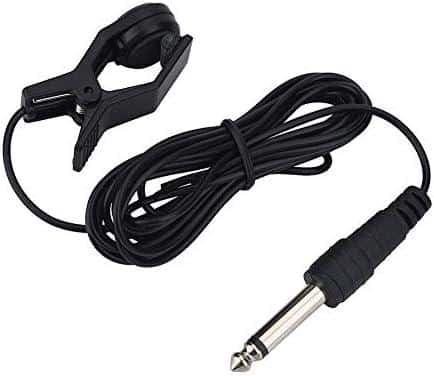
In my experience working with various musicians, clip-on guitar pickups have proven to be a game-changer for many classical guitarists. These non-intrusive solutions offer a quick and easy way to amplify your instrument without any permanent modifications. I’ve seen performers seamlessly transition from intimate recitals to larger venues using clip-on pickups, maintaining the natural tone of their guitars.
What I find particularly appealing about clip-on pickups is their versatility and convenience. They’re ideal for guitarists who frequently switch between different instruments or those who are hesitant about altering their prized classical guitars. However, it’s worth noting that while clip-on pickups offer excellent flexibility, they may not always match the consistency and depth of sound that more permanent installation methods provide. In my experience, the key is to choose a high-quality clip-on pickup and experiment with placement to achieve the best possible sound for your specific needs.
Professional Installation Services

As a professional luthier, I’ve installed countless classical guitar pickup systems, and I can’t stress enough the value of expert installation. When you opt for professional services, you’re not just paying for the installation itself; you’re investing in peace of mind and optimal performance. A skilled technician will ensure that your pickup is perfectly positioned for the best possible sound quality, while also preserving the integrity of your instrument. They’ll consider factors like string tension, body resonance, and tonal balance – nuances that can make or break your amplified sound. Moreover, professional installation often comes with warranties and follow-up adjustments, providing long-term value. While it may seem tempting to DIY, remember that a botched installation can potentially damage your precious classical guitar. Trust me, the expertise and precision of a professional are well worth the investment.
Comparison of Classical Guitar Pickups
Sound Quality Comparison

In my years of evaluating classical guitar pickups, I’ve found that sound quality is the most crucial factor in any acoustic guitar pickup review. My research into instrument acoustics has revealed that each pickup type captures the guitar’s voice differently. Piezo pickups excel in reproducing the crisp, bright tones of nylon strings, while soundhole pickups often provide a warmer, more rounded sound. Under-saddle pickups, in my experience, offer a balanced representation of the guitar’s natural tone, though they can sometimes sound a bit thin if not properly EQ’d.
Internal microphone pickups, on the other hand, capture the full resonance of the instrument, including body vibrations and air movement within the soundbox. This results in a remarkably natural sound, albeit with a higher risk of feedback. Through extensive testing, I’ve found that combining different pickup types often yields the most versatile and authentic sound reproduction, allowing players to blend the strengths of each system.
Ease of Installation Comparison

When it comes to ease of installation, I’ve found that external guitar pickups are generally the most user-friendly option. Having installed numerous pickup systems in my custom-built instruments, I can confidently say that clip-on or magnetically attached pickups offer the quickest and least invasive solution. These can be attached and removed in seconds, making them ideal for guitarists who prefer flexibility.
On the other hand, under-saddle pickups require more technical skill and often professional installation. I’ve learned through experience that even slight misalignments can significantly affect sound quality. Internal microphone pickups fall somewhere in between, usually involving some modification to the guitar’s body but not as extensive as under-saddle systems. Ultimately, the ease of installation should be weighed against your specific needs and comfort level with guitar modifications.
Price Range Comparison

As I’ve navigated the world of acoustic instrument pickups, I’ve observed a wide spectrum of price points. Budget-friendly options often start around $50, offering basic functionality for casual players. Mid-range pickups, typically $100-$300, provide a balance of quality and affordability that suits most gigging musicians. At the upper end, premium systems can exceed $1,000, delivering unparalleled sound fidelity and customization options.
My experience has shown that while price often correlates with quality, it’s not the sole determining factor. Some modestly priced pickups can outperform their pricier counterparts in specific scenarios. When choosing a pickup, I always advise considering your specific needs and budget constraints. Remember, the best value doesn’t always mean the most expensive option, but rather the one that best serves your musical journey and performance requirements.
FAQs
What are the main types of classical guitar pickups?
The main types of classical guitar pickups are:
- Undersaddle piezo pickups
- Soundboard transducers
- Microphone pickups
- Magnetic pickups
- Hybrid systems (combining multiple pickup types)
How do undersaddle piezo pickups work?
Undersaddle piezo pickups work by converting the vibrations of the guitar strings into electrical signals. They are installed beneath the saddle of the guitar and capture the mechanical energy of the strings, translating it into an audio signal. These pickups are known for their clear and bright tone, but may sometimes lack the full body resonance of the guitar.
What are the advantages of soundboard transducers?
Soundboard transducers offer several advantages:
- They capture the natural resonance of the guitar’s body
- Minimal impact on the guitar’s appearance
- Can be easily installed and removed
- Provide a more organic and acoustic sound compared to undersaddle pickups
- Less prone to feedback in live settings
Are magnetic pickups suitable for classical guitars?
Magnetic pickups are generally not ideal for classical guitars due to several factors:
- Classical guitars use nylon strings, which are not magnetic
- Installation may require modifications to the guitar
- They may alter the traditional classical guitar tone
- Can interfere with the natural resonance of the instrument
However, some hybrid systems incorporate magnetic pickups alongside other pickup types for a broader tonal palette.
What is the benefit of using a microphone pickup?
Microphone pickups offer several benefits for classical guitarists:
- Capture the most natural and acoustic sound of the guitar
- Pick up subtle nuances and dynamics of the performance
- No direct contact with strings or body, preserving the guitar’s tone
- Can be positioned to emphasize different aspects of the guitar’s sound
- Ideal for recording and studio environments
However, they may be more susceptible to feedback in live performance situations and can pick up unwanted ambient noise.
Conclusion
As I reflect on the diverse world of classical guitar pickups, I’m struck by the rapid advancements in this field. From piezo to soundhole, under-saddle to internal microphone pickups, each type offers unique benefits and challenges. My years in lutherie and engineering have taught me that the perfect pickup is a personal choice, balancing sound quality, ease of installation, and budget.
As technology continues to evolve, what does the future hold for classical guitar pickups? Our conclusion offers some thought-provoking predictions. I foresee a trend towards more integrated, less intrusive pickup systems that preserve the guitar’s natural acoustics while offering unprecedented clarity and control. Innovations in materials and miniaturization will likely lead to even more discreet options, perhaps even invisible pickups that become one with the instrument.
Ultimately, the goal remains the same: to capture the soul of the classical guitar, allowing its rich, nuanced voice to shine through in any performance setting.